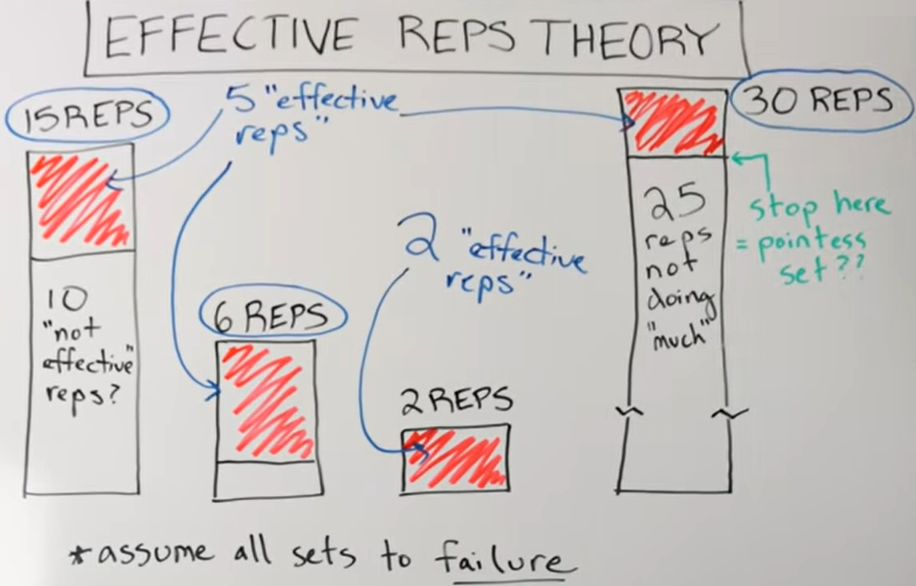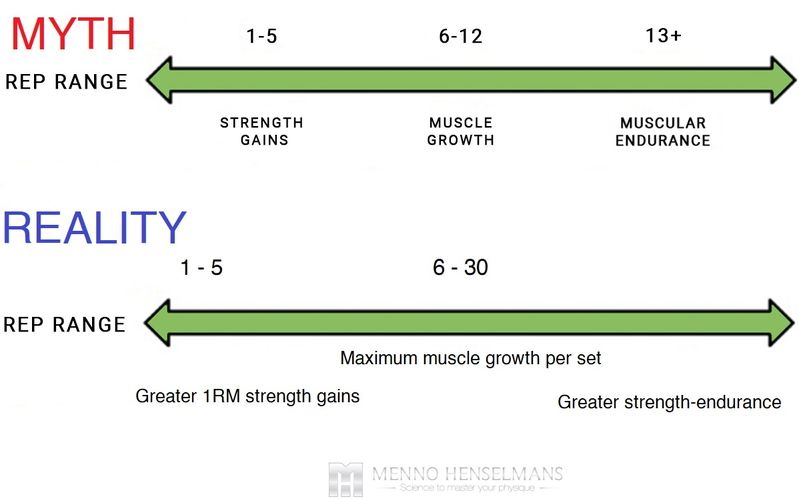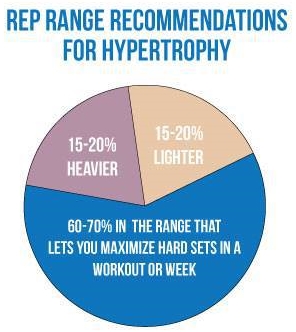A rack full of dumbbells, ranging from 6 to 40 kilograms, shines in front of you. All patiently waiting to be grabbed by you. But what weight should you use for that dumbbell press chest, shoulder press, row, curl or whatever? Can you just ‘blindly’ grab a dumbbell and start making progress from that weight? About how to choose the right training weight if maximum muscle growth is your goal.
1. If you train for muscle growth, it is not so much the training weight that matters (the absolute intensity) but the effort you put in with it (the relative intensity): regardless of the weight, you should train your sets close to muscle failure. So if you make enough effort, in theory it doesn’t matter whether you train with light or heavy weights; with both it is possible to build maximum muscle mass. However, there is a lower limit of around 30%1RM (a weight with which you can do 30-40 repetitions).
2. We usually express the relative intensity in Reps In Reserve (RIR), or the number of repetitions that you stay away from muscle failure. At 1 RIR, for example, you stop the set when you could do one more rep.
3. There are all kinds of practical objections to training with very light or very heavy weights. That is why it is best to train with weights between 65%1RM and 85%1RM, so in the range of 6-15 repetitions.
4. Train your compound exercises with relatively heavy weights (6-10 reps @ 1-3 RIR) and isolation exercises with relatively light (10-15 reps @ 1-2 RIR). For more advanced bodybuilders, it pays to do some sets outside the 6-15 rep range.
ABSOLUTE INTENSITY
First some terminology. The heaviness of a weight (the number on, for example, the dumbbell) is also called the absolute intensity. Although “absolute,” this intensity is often expressed as a percentage of the one-rep max (1RM), the weight you can use to complete one full rep. We do this because we are not all equally strong: what is heavy weight for one person feels like a feather for another, so to speak.
REPRANGE
The weight you choose determines the rep range in which you train, i.e. how many repetitions you do per set. If you choose a weight equal to your 1RM, you can only complete one full rep. If you choose a weight between 65 and 85% of your 1RM, you can do 6 to 15 repetitions with it. If you’re new to strength training or if you’re doing an exercise for the first time, it’s simply a matter of trying out how many reps you can get with a certain weight.
RELATIVE INTENSITY
Relative intensity is the effort you put in, i.e. how far you train a set to muscle failure. Muscle failure is the point where you can no longer do a decent rep: the muscle is exhausted. Usually the relative intensity is expressed in Reps In Reserve (RIR). For example, 2 RIR means you stop the set two reps before muscle failure; you keep two reps ‘in the tank’. At 0 RIR you train completely until muscle failure: there are no more repetitions left.
Relative intensity is crucial in bodybuilding training. Because whatever weight you use, ‘something’ will only happen in a muscle if it is sufficiently fatigued with that weight during a set. Doing ten reps when you could do five more (5 RIR), so not much help. In this example, the most growth stimulus only arises after the tenth repetitions. Only then do you really have to struggle to complete the repetitions properly. Relative intensity (effort) is therefore more important than absolute intensity (load) in bodybuilding training:
EFFECTIVE REPS
Sufficient effort during a set produces enough so-called effective (or stimulating) repetitions. By this we mean the roughly five last repetitions in a set, just before muscle failure, which, as mentioned, cause the most growth stimulus, to be more precise: the most mechanical tension, the main training mechanism behind muscle growth. Viewed in this way, muscle growth is not so much about the amount of weight and/or the total number of repetitions, but about the amount of effective repetitions that a training produces.
In order to create enough effective reps, you must not only put in enough effort, but also do enough sets: for an average bodybuilder per muscle group 10-20 sets per week, spread over at least two weekly workouts. Doing too many sets is also not good, as both your growth potential and your recovery capacity are limited (assuming you’re a natural).
 According to the theory of effective reps, only the last about five reps of a set are important for muscle growth, assuming you train the set to muscle failure. Source: YouTube/Jeff Nippard .
According to the theory of effective reps, only the last about five reps of a set are important for muscle growth, assuming you train the set to muscle failure. Source: YouTube/Jeff Nippard .Effective reps are currently often the subject of debate. Because although many coaches endorse the theory, there are also ifs and buts. Likewise, it is not the case that the other repetitions in a set (the so-called ‘non-effective’ ones) do not give any growth stimulus. Especially with heavy compound exercises, the ‘early’ repetitions in a set can also be quite stimulating.
TOO MUCH EFFORT IS ALSO NOT GOOD
However, you should definitely not train all your sets to the limit. Training to muscle failure does provide the greatest growth stimulus, but this is offset by disproportionate fatigue, especially if you do it with compound exercises. Too much of that fatigue has a negative impact on the rest of your training performance and it means that you need much more recovery capacity after training. As a result, your recoverable volume (also called Maximum Recoverable Volume, MRV) decreases for the following workouts, which means you can do less productive sets and therefore create fewer effective repetitions on balance. You should therefore view the training result over several sets and not per set.
Most coaches generally recommend using 1-3 RIR. Occasional training to muscle failure is fine when it comes to isolating exercises. So you mainly train in the area indicated in the image below. More about training to muscle failure in this article.
Dit bericht op Instagram bekijken
BOTH LIGHT AND HEAVY WEIGHTS ARE EFFECTIVE
We have seen that for muscle growth mainly the effort (relative intensity) is important and not – as with powerlifting – the weight (absolute intensity). That means that it doesn’t really matter whether you train with light or heavy weights, as long as you train close to muscle failure and that way get your effective reps. This has also been demonstrated several times by scientific research, such as in a meta-study by hypertrophy expert Brad Schoenfeld from 2017 [ i ] , and again, for example, in a recent study by Morton ea [ ii ] .
There is a lower limit: weights lower than 30%1RM are not optimal for muscle growth [ iii ] . In an article by scientist Chris Beardsley you can read why this is so.
In addition, for light weights, so say as soon as you train above 20 repetitions, that you have to train until complete muscle failure to create sufficient growth stimulus. With heavier weights, you can stay 1-3 reps away from muscle failure for an equivalent growth stimulus.
So in principle it doesn’t matter which rep range you choose, as long as you operate roughly between 1 and 30 repetitions and as long as you train close to muscle failure. And so it is a myth that there is a rep range specific to muscle growth (the hypertrophy range). It is true that you build up more maximal strength in the lower rep ranges and more strength endurance in the higher rep ranges, but in principle it makes no difference for muscle growth.
 There is no hypertrophy range. Anything up to 30 reps is enough for maximum muscle growth. Source: Menno Henselmans.
There is no hypertrophy range. Anything up to 30 reps is enough for maximum muscle growth. Source: Menno Henselmans.THEORY VERSUS PRACTICE
We just said ‘in principle’, because you also have to look at what works best in practice. And then a preferred reprange comes to the fore.
HEAVY WEIGHTS IN PRACTICE
Training with very heavy weights (>85%1RM), with which you can do no more than five or six repetitions, has a number of disadvantages for the bodybuilder:
- You may be missing out on some effective reps, especially if you’re doing fewer than five reps. This means less volume, which you should compensate by doing more sets;
- It puts more strain on your tendons and joints, increasing the risk of injury. Especially older bodybuilders get very heavy weights are therefore better left;
- It is more taxing on your nervous system (more acute stress);
- Correct execution of exercises is more difficult (you will cheat faster);
- It is often more difficult to make a good mind-muscle connection because you are more focused on handling the weight;
- You have to do more warm-up sets, which costs you more training time;
- You need to rest longer between sets, which also takes more time.
LIGHT WEIGHTS IN PRACTICE
On the other hand, training with very light weights (<~40%1RM) is also not ideal for muscle growth:
- Training lengthy sets to complete muscle failure is almost impossible, because cardiovascular fatigue usually sets in earlier than muscular fatigue. In other words: your heart and lungs give up before your muscles. As a result, you still do not create an adequate training stimulus for muscle growth, no matter how heavy the set (from a cardiovascular point of view) was. A heavy set is therefore not by definition an effective set;
- You have to do a lot of reps before you get to the effective reps. Basically, you’re doing a lot of wasted reps, which just cause unnecessary cardiovascular and central fatigue;
- Training very long sets to muscle failure is also mentally tough. Most people experience this as an unpleasant way of training, apart from the fact that it takes more time;
- With long sets, you use more slow twitch muscle fibers, the slow-twitch fibers that are mainly used for endurance efforts. These muscle fibers have less growth potential than the fast twitch muscle fibers that you use for short, heavy efforts.
THE PREFERRED REPRANGE
In this sense, as a bodybuilder, it is best to train with weights between 65 and 85% of your 1RM, or weights with which you can complete 6-15 repetitions: not too light, not too heavy. This rep range best allows you to do high-quality sets, so with sufficient effort, without unnecessary fatigue and with a low injury risk.
VARIATIONS WITHIN THE PREFERRED REP RANGE
6-15 reps is still a pretty wide range. Which weights you choose is actually mainly a matter of personal preference and circumstances. To spare your tendons and joints, we advise you not to train exclusively with 6-10 repetitions. From an injury point of view, it is better to train isolation exercises with sets of more than 8 repetitions.
Author Greg Nuckols of Stronger by Science has dabbled in the subject of repranges a number of times. Based on that expertise, he makes the following recommendations per exercise [ vi ] :
- squats and deadlifts: 5-10 reps;
- rows: 8-15;
- pull ups/chin ups: 5-10;
- barbell presses: 5-10;
- dumbbell presses: 8-15;
- unilateral leg exercises: 8-15;
- isolation/machine exercises: 8+.
TRAINING OUTSIDE THE PREFERRED REP RANGE
Does the foregoing mean that you should only train in the spectrum of 6 to 15 reps? No, preferably you also do some sets outside that range, so with both very heavy (3-6 reps) and very light (15-30 reps) weights.
You may be addressing different signaling pathways for muscle growth , optimizing different types of muscle growth (myofibrillar and sarcoplasmic hypertrophy), and/or optimally stimulating all types of muscle fibers. Low rep ranges for pure strength also make you stronger and that in itself may also be beneficial for building muscle mass
Process different repranges in one training program, ie no block periodization. With the latter you run the risk of losing adaptations from the previous block.
More on using different reprangs in this article.
ADVICE
For practical reasons, it is best to train mainly in the range of 6 to 15 repetitions, taking into account an average of 1-3 repetitions that you leave ‘in the tank’ (1-3 RIR). You train large, compound exercises mainly with 6-10 repetitions, isolation with 8-15 repetitions.
For more advanced athletes, it may also make sense to do some work in the 3-6 and 15-30 rep ranges as well. It is best to pour those different rep ranges into one training program and not do it block by block. Assume a breakdown like this:
60 to 70% in the range of 6-15 reps;
15 to 20% in the range of 15-30 reps;
15 to 20% in the range of 3-6 reps.
 How to divide the different rep ranges in a training program. Source: Stronger by Science.
How to divide the different rep ranges in a training program. Source: Stronger by Science.For example, if you wish, you can devote one weekly session to lighter weights/metabolic stress. Nice for a change and you will also spare your tendons and joints for a day.
CONCLUSION
Early on, when there wasn’t much scientific research available yet, bodybuilders thought there was a ‘hypertrophy reprange’. Often they learned that muscles only grow if you do between 8 and 12 repetitions. If you do less, you mainly train strength, if you do more, you mainly train strength endurance, it was said.
Fortunately, we now know better: for muscle growth it’s not about the number of reps per se, but about the number of reps that you stay away from muscle failure – that is, the effort.
Yet there are practical reasons why you should avoid very low and very high rep ranges. It is therefore best to operate between 65 and 85% of your 1RM, which comes down to 6-15 repetitions.
In that sense, good old 8-12 is a great rep range for muscle growth, albeit for different reasons than was once thought.